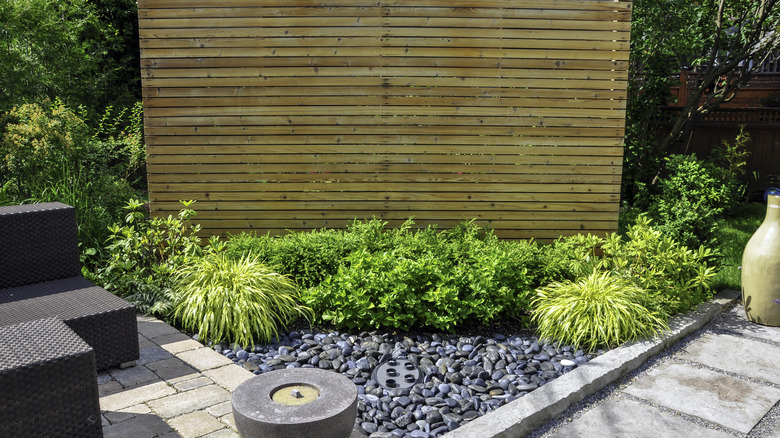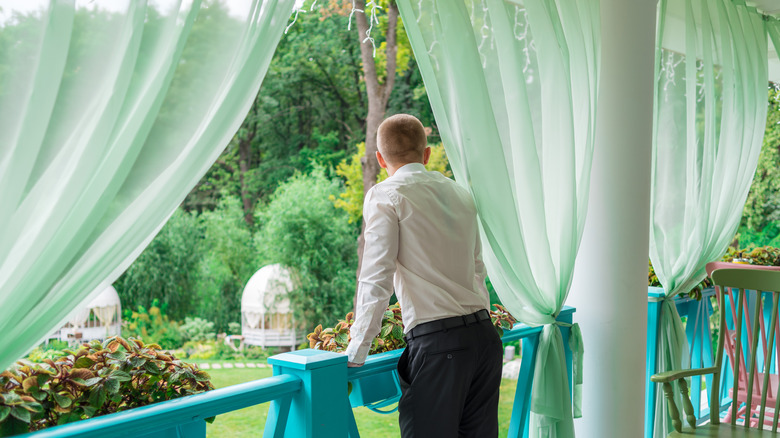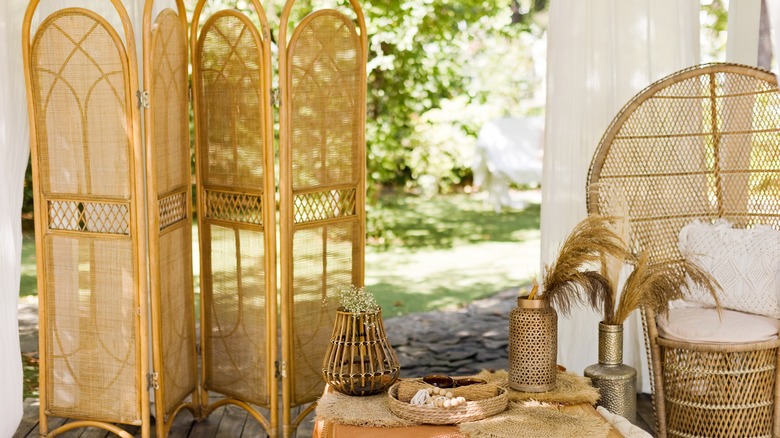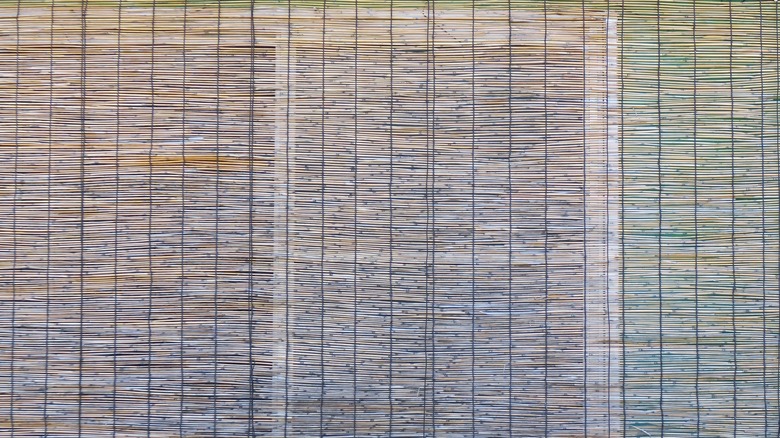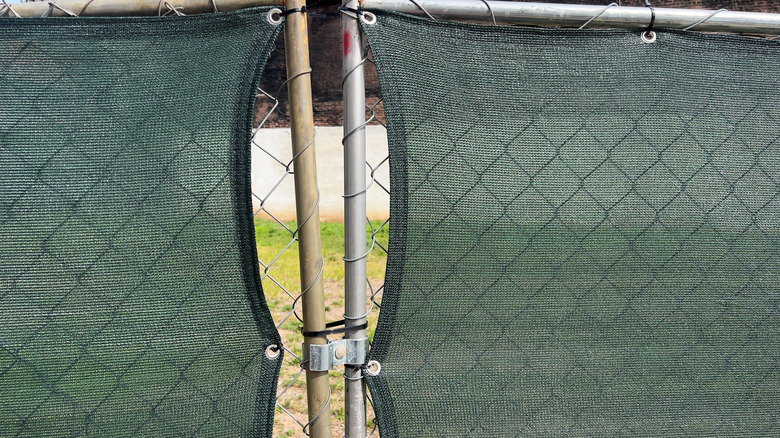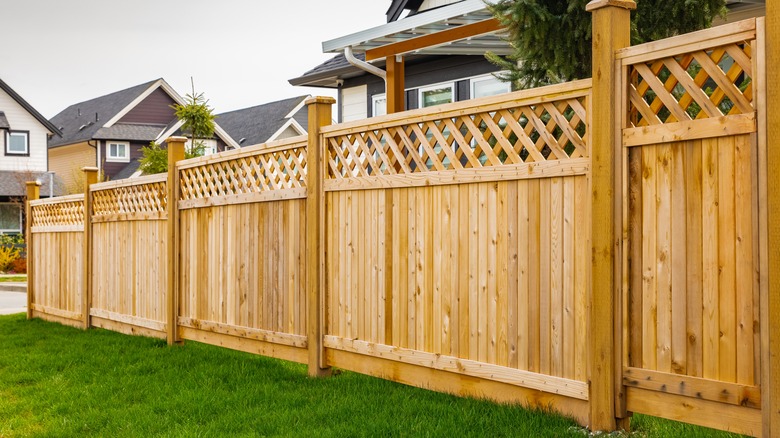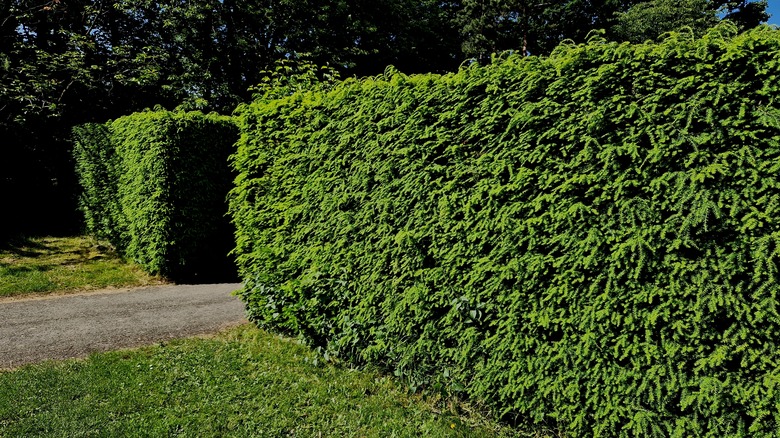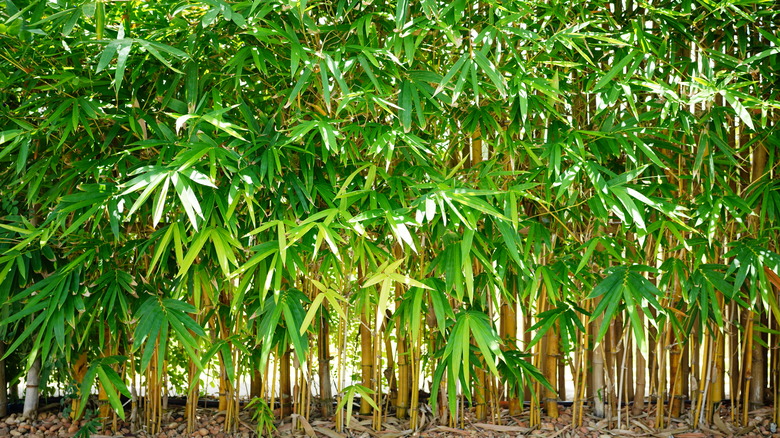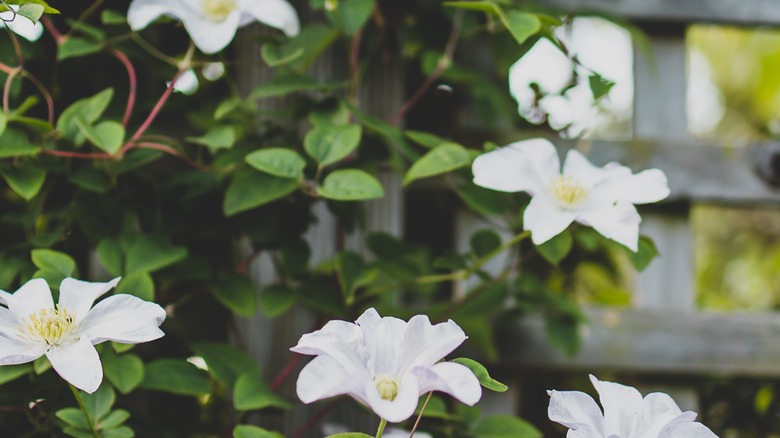Create Some Privacy In Your Outdoor Space With These Budget-Friendly Solutions
Your home is a welcoming retreat from the stresses of the world, and maximizing your outdoor living space through decorations should offer a serene haven where you can relax and enjoy some peace and quiet. Right? But what if your outdoor area is visible to neighbors and passersby? If that's the case, you'll want to take steps to block sight lines and muffle ambient noises that invade your outdoor sanctuary. On the other hand, you might be operating on a tight budget that doesn't allow you to invest in expensive materials. No worries. We've curated a collection of outdoor privacy solutions that won't stress your wallet.
To make your exterior living space more secluded, you can hang outdoor curtains or install weather-resistant fabric screening. For a natural look, you might cover a chain-link fence with roll-out reed screening. Don't forget about gardening solutions for privacy issues. With carefully placed shrubs, hedges, and vines grown on lattice panels, you can ensure privacy while you make your garden lovelier than ever. Read on to discover low-cost solutions that will make your outdoor living area a quiet refuge from the busy world outside.
Use outdoor curtains to transform your porch or patio into a private oasis
Nothing transforms your outdoor living space into a romantic getaway quite like the sight of lovely curtains billowing in a soft breeze. They not only ensure privacy but also protect you from the ultraviolet rays of the sun. Additionally, caring well for outdoor curtains lends a decorative touch when they are mounted to the vertical supports of a porch, pergola, gazebo, or pop-up canopy tent. They're also an economical solution to gaining more privacy for your outdoor retreat. For example, Exclusive Home Store's outdoor curtains on Amazon are available in a wide range of sizes and colors at a budget-friendly price.
When you select curtains for your outdoor living area, it's best to choose a weather-resistant fabric and a style that can integrate seamlessly into your outdoor space. Curtains with grommets at the top can be mounted on curtain rods using brackets attached to vertical wooden posts. On a porch, you might opt to install a ceiling track to hang your curtains.
Alternatively, you can put them on heavy wire or sisal rope held taut between eye bolts. Choose from a variety of available colors and patterns to suit your décor preferences. To keep the curtains in place when the wind picks up, you'll want to attach curtain weights like Jetec's magnetic curtain weight, available on Amazon. Clip several of the magnetic weights to the bottom of each curtain panel to keep them from blowing wildly in the breeze.
Freestanding privacy screens make your outdoor space feel like an actual room
You will feel more calm and relaxed in your outdoor space when you know prying eyes are not watching your every move. If your patio, porch, or balcony is in view of the neighbors, you might want to consider a freestanding screen as an answer to the privacy problem. The solution couldn't be simpler, as there is no installation necessary. Simply place the screen wherever you want to disrupt sight lines into your outdoor living area. You can also choose from a plethora of screen types to complement your décor style, and you won't need to stress your bank account in the process.
When you're shopping for a freestanding privacy screen, look for weather-resistant materials, including metal, vinyl, resin, and wood, that have been treated and sealed. Examples include Enclo's vinyl screen with planters from Lowe's and Best Choice's pair of wooden planter screens, which are available on Amazon. Perhaps you're not interested in growing plants that climb over your freestanding screen. In that case, you might choose a simple option, like the FENCY metal screen on Amazon. If you place your screen in a location where it might blow over in a storm, you'll want to anchor it. This can be accomplished by attaching the privacy solution to vertical posts or pegs installed firmly in the ground.
Roll-out reed screening blocks sight lines to make your outdoor space more private
Perhaps your outdoor space includes see-through fencing or balcony railings that provide boundaries but do not block visibility into your outdoor living area. If you have a pre-existing vertical structure, it's cheap and easy to cover it with roll-out reed screening that creates instant privacy while contributing a casual and natural vibe to the space. This type of screening consists of reeds made from thin bamboo or other natural materials woven together with wire or heavy string. It's available in rolls of varying lengths to accommodate your project. For example, you might use several rolls of bamboo screening of a 4-foot height to cover a chain link fence along your property line. Alternatively, a roll of reed screening of a 6-foot height would provide ample privacy for a small apartment balcony.
Roll-out reed screening is available in a variety of thicknesses and textures, including Backyard X-Scapes eco-friendly bamboo reed, selling on The Home Depot and ZNCMRR's natural reed fencing rolls on Amazon. Installation is straightforward and simple. You'll need zip ties, like Hyper Tough cable ties from Walmart, to affix the screening material to the railing of a balcony or porch or to a chain-link fence. For a more heavy-duty application, you might use galvanized wire or metal staples. These materials work well to attach the reed screening as a cover for a permanent wooden fence.
For a sleek solution, install weather-resistant fabric screening on balconies, decks, porches, and fences
If you're looking for a sleek material to obstruct the view of nosy neighbors into your outdoor living space, you may want to consider weather-resistant fabric options like Windscreen4less Store's balcony privacy screen on Amazon. They're made from high-density polyethylene (HDPE) plastic for durability in the outdoor environment. The woven texture of the fabric allows air circulation and filtered light while shading your space from the harmful UV rays of the sun.
Additionally, it shields your outdoor living area from the wind. The screens are available in a wide range of heights, lengths, and colors. Use a fabric screen on a balcony or patio or upgrade the look of an old fence. Chain-link fencing is durable and economical, but it's far from aesthetically pleasing. For that reason, many people invest in weather-resistant fabric screening to camouflage chain-link fences and give them a more refined look in the landscape. ColourTree's chain link privacy screen from Lowe's is a great example.
Installing the outdoor fabric privacy screens couldn't be easier. They're equipped with grommets, allowing you to attach them directly to fences, railings, or other pre-existing structures using plastic zip ties. Alternatively, you might use bungee ball cords like these from Amazon. Start in one top corner of the screen and attach every grommet all the way across and down the edges of the fabric. Make sure the fabric is flat and smooth, but don't stretch it overly tight. Be sure to attach the grommets along the bottom edge as well as the top and side edges.
Traditional wood privacy fences are a sizable investment, but they're cheaper than other options
Installing a wooden privacy fence along the boundaries of your garden provides a permanent solution to the quest for seclusion in your outdoor space. To be considered a privacy fence, the structure must be at least 6 feet tall. It's a big investment, but a wood fence is more economical than other options. According to Forbes, a wood privacy fence costs an average of $17.00 to $22.00 per linear foot for new installation. On a positive note, the price of wood fencing is less expensive than vinyl, wrought iron, brick, and stone.
Wooden privacy fences offer several advantages for homeowners. They block out noise as well as prying eyes, and keep animals and intruders out while restricting pets and children inside the enclosed area. On top of that, the wood material adds a warm and natural vibe that complements your garden. Pine and spruce are the most economical woods for fencing, but cedar and redwood offer greater durability, although they cost more.
You can customize a wooden privacy fence by choosing from several different styles, including horizontal boards, stockade, board-and-stringer, and shadowbox styles. Select the option that best suits your privacy needs and aesthetic preferences by perusing our guide on the different types of wooden fences. If you treat and maintain the wood with a sealant, the fence should last 15-to 20 years.
Plant hedges, trees, and tall shrubs in the ground or in large pots for natural beauty and privacy
Your privacy screen doesn't need to be a man-made product. Instead, it can be a living and growing part of your landscape. When you're designing the garden, keep privacy in mind and locate a few large plants with full foliage in spots where they'll block the sight lines into your outdoor living space. Start by taking a look at the best hedges you can plant in your yard for privacy.
These densely packed branches muffle outside noises and obstruct the view of your garden from passersby. For a thick and healthy hedge, you might plant your shrubs in two staggered rows, placing the large plants 6 to 8 feet apart diagonally. Evergreen shrubs and trees will provide the best year-round privacy. Consider arborvitae, cypress, juniper, cedar, laurel, holly plant, and yew as viable options for a beautiful and effective privacy hedge.
On a patio, deck, or porch, you can gain privacy by cultivating large plants in clustered containers, creating a hedge-like effect for your outdoor living area. Arborvitae, Japanese maple, cypress, and bay trees will grow in large pots. Shrubs like boxwood, juniper, and dwarf aucuba will thrive in containers. Be sure that the containers are large enough to allow room for the roots of your trees and shrubs to grow. If you're trying to create privacy on a porch or balcony, you might place some of the shorter potted plants on tables or benches.
Plant a living screen of fast-growing bamboo to ensure privacy for your outdoor space
A row of bamboo planted in the garden offers a fast-growing and dense screen that transforms your outdoor living area into a private oasis. Many species grow as much as 3 feet per day. In fact, the Guinness Book of World Records cites certain species of bamboo as the fastest-growing plants in the world. With its density, spreading ability, and tolerance for a wide range of soil and sunlight conditions, bamboo is an attractive plant that establishes quickly to ensure privacy in a short time.
However, when growing and taking care of bamboo plants, the main thing to know is that they spread so invasively. Bamboo threatens the biodiversity of locations where it's planted, robbing native plants of water and nutrients in the soil. If you live in a close-knit community, a bamboo privacy hedge can make you unpopular with your neighbors. It takes over lawns and planting beds, spreading beyond fences and property lines to become a nuisance.
On top of that, it's extremely difficult to eradicate once it starts growing. The baby bamboo shoots pop up all over the garden from underground rhizomes that spread as much as 20 to 40 feet from the plant in only one season. Getting rid of bamboo may take years of digging, along with repeated applications of herbicides. To minimize the rampant spreading effects of bamboo, you might look for a clumping species rather than the more common running type. Clumping bamboo will spread only a few inches per year, but the plants gradually expand to 3 to 10 feet in diameter.
When climbing vines grow on vertical lattice panels, your garden becomes an enchanting, private getaway
When your garden design incorporates beautiful plants that offer the bonus feature of screening for privacy, you have a win-win situation. This is what happens when lovely climbing plants that don't take over your wall grow on tall, vertical lattice panels positioned to cut off sight lines and dampen noise from the outside world. Lattice panels are constructed from narrow slats of wood or vinyl assembled to create openings in square or diamond shapes. Pressure-treated pine lattice panels, as well as diamond vinyl lattice panels, are available at The Home Depot.
To erect a vertical section of lattice in a planting bed, you'll need to install two vertical posts. You may choose to drive spiked metal post holders into the ground with a sledgehammer. Then, insert the posts and secure them with screws. Alternatively, you might use a post-hole digger to excavate holes where you insert the posts and secure them with cement or gravel. Once the posts are erected, you can nail the lattice panels to the posts to create the screens.
The next step is to plant climbing perennials at the base of the lattice panels and allow them to cover the vertical surfaces as they grow. Creeping vines like ivy, Virginia creeper, and hops offer lovely foliage to create a privacy screen. If you want to add flower power, plant-star jasmine, trumpet vine, climbing roses, wisteria, or clematis to grow up over your lattice screens. Enjoy their seasonal beauty as you relax in a serenely private garden.
